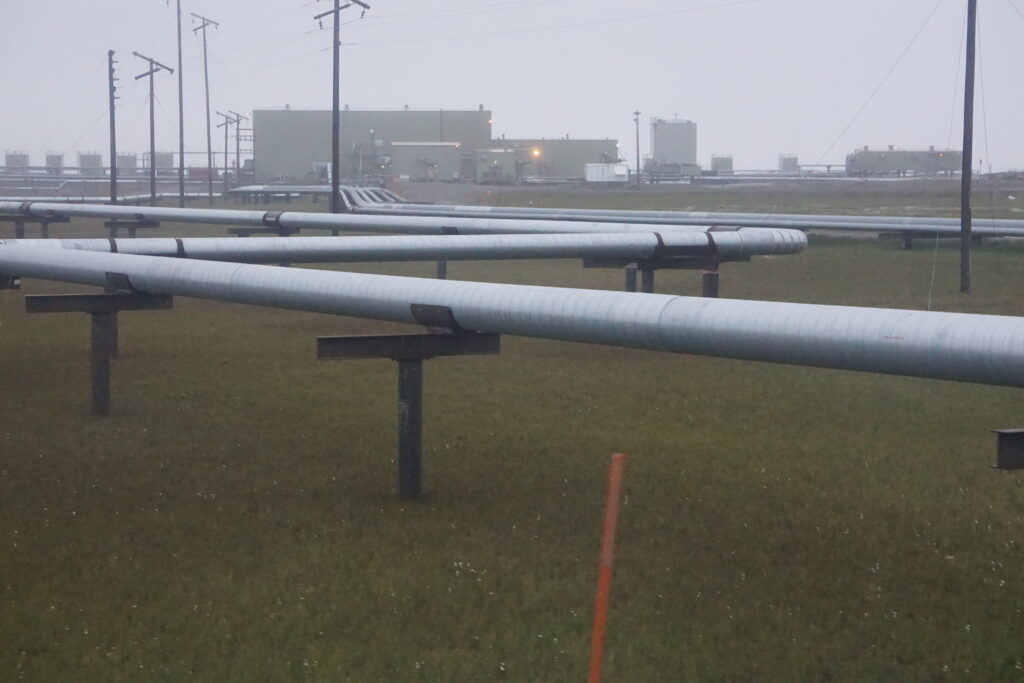![]()
A network of pipelines, seen on Aug. 23, 2018, snakes through a portion of the Greater Prudhoe Bay Unit on Alaska’s North Slope. (Photo by Yereth Rosen/Alaska Beacon)
Late developments in this campaign season remind us of the often-attributed Mark Twain saying, “a lie can travel halfway around the world before the truth can get its shoes on.” We want to set the record straight and address falsehoods swirling around about Alaska’s oil taxes.
In 2014, we joined over 500 Alaskan businesses and leaders throughout the state to oppose a ballot measure that would have reversed Alaska’s current oil tax structure (Senate Bill 21). This ballot measure failed because voters from across our state – from Fairbanks to Anchorage to Utqiagvik – wanted to avoid going back to a time of dangerous oil production declines that would have dealt a body blow to Alaska’s economy.
Now, 10 years later, the same old rhetoric citing a long-debunked “giveaway” to oil companies has resurfaced, coupled with outrageous assertions that the current oil tax structure is somehow the reason four Fairbanks schools are closing. We proudly maintain our support for the oil tax reform that passed a decade ago. We do so because the facts demonstrate it was the right decision for Alaska’s economic future.
The truth is plain to see for anyone who takes time to do the research. Even through tumultuous swings in oil prices, and a global pandemic, Alaska oil production did not drastically decline under the current tax system reaffirmed by the voters 10 years ago. Instead, we have maintained a tax system that has proved to be competitive and attractive to investors at high and low oil prices, leading to increased activity, both in existing and new oil fields.
And that increased activity is paying off today; oil production stopped its freefall and stabilized over the last decade at just under 500,000 barrels per day. Even more exciting are the two major discovery wells that were drilled in the Pikka (2013) and Willow (2016) fields. Billions are being spent on these megaprojects now, and these new fields are set to dramatically increase the amount of oil flowing through the pipeline as the state predicts oil throughput will climb to 600,000 barrels per day by 2032, a level not reached in more than 20 years.
More production leads to more oil royalties – which means billions of dollars in direct deposits into the Permanent Fund. No other industry remotely compares to oil’s direct contributions in support of paying PFDs.
But let’s talk about the single most important thing to Alaskans – especially for us as a former labor leader and current small business owner – spending, economic activity, and jobs for Alaskans.
Today, industry spending supports more than 1,000 Alaskan businesses. With the billions being spent on the Slope right now, some contractors report being busier than they were during the pipeline days nearly 50 years ago. Today, it is hard for union halls and employers to meet the demand for workers, which is a problem we welcome.
The absolute last thing Alaska needs is to reverse course and pump the brakes on the exciting momentum growing our economy and creating new economic opportunities for Alaskans.
The resurgence of the oil industry is one of the bright spots in Alaska’s economy today. Don’t be misled by falsehoods being blasted over the airwaves in the waning hours of this campaign season. Let’s keep Alaska growing, now and in the future.
Rick Boyles, Rick Mystrom, Linda Leary, and Bob Berto were co-chairs of the successful 2014 No on 1 campaign.
GET THE MORNING HEADLINES.

